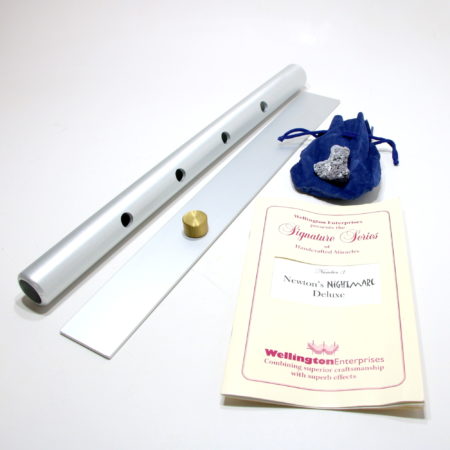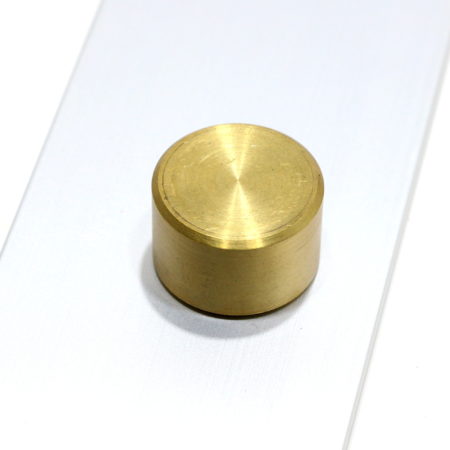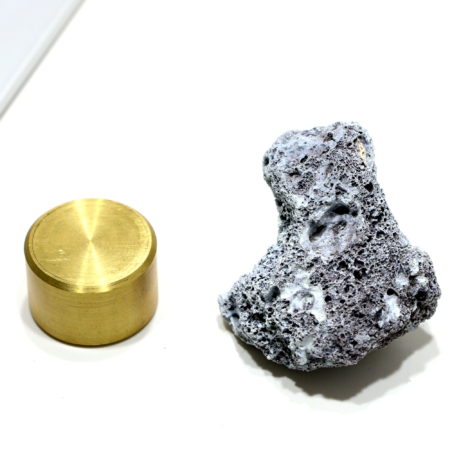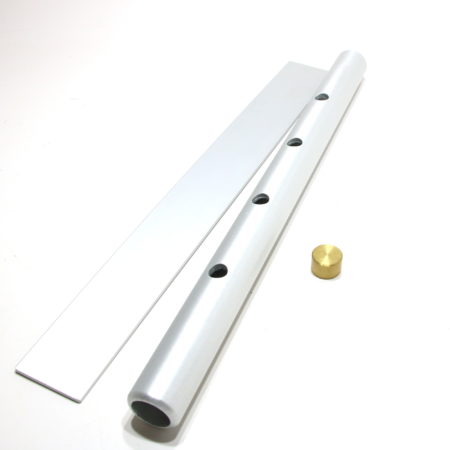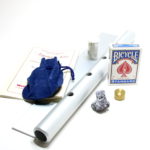Description
This is an application of Lenz’s Law and there have been a number of effects based on this phenomenon including the beautiful Mystic Tubes of Sea-Ling by Richard Gerlitz and Paul Green’s comedy presentation: Field Sobriety Test.
However, for my money, if you want to perform the effect this is the best version. This routine is structured so each phase builds until you are convinced that that the moon rock is real and magical. This is a great example of how a good routine can transform a simple science experiment into full on wizardry! The belief is aided by the beautiful props that are solid and look genuine as you have come to expect from Wellington Enterprises.
There is a simple switch involved but because the routine is so well structured you’ll have plenty of cover and if you want to perform this you’ll quickly master it even if you avoid other effects that require a switch.
These are now getting hard to track down, but well worth the effort if you like creating miracles 🙂
Effect: In 1687, Isaac Newton set down in writing his laws of motion. In 2003, Wellington Enterprises breaks his laws and you can demonstrate that with the third release in our Signature Series Collection. The action takes place in the spectator’s hands and the props appear quite ordinary. The magician displays an aluminum tube about a foot and a half long and a small brass block that easily fits into the tube. Ask a spectator to hold the tube vertically with one hand and drop the block into the top with the other and then catch it at the bottom with the same hand. The block falls to the bottom in a fraction of a second. The quick can catch it.
Offer to make the task easier. The magician removes a very special rock from its suede bag explaining that it is an actual piece of moon rock. Amazingly, even on earth, this rock retains its unique lunar properties. Explaining that gravity on the moon is one sixth that of earth, the spectator is asked to pass the moon rock along the length of the tube and then to try the drop again. This time, the block defies gravity and falls slowly through the tube. You have to see this to believe it. Holes along the length of the tube allow everyone to see the block floating down the length of the tube. The spectator must wait with his hand at the bottom of the tube for the block to fall through.
The demonstration is repeated with a flat aluminum strip. The spectator is asked to initial a small sticker that is then attached to the brass block. Next he’s asked to hold the flat strip at a steep angle and to place the brass block at the top and release it. The block glides quickly down. The spectator passes the moon rock along the length of the strip and tries it again. Even though the marked block has remained in the spectator’s possession, it now glides slowly and eerily down the strip proving the powers of the moon rock!
Everything can be minutely examined. They will find nothing. We supply all you need for the complete presentation. It’s easy to do and a real fooler. In fact, it’s so unique that you’ll amuse yourself with it. If only Isaac Newton could see this!
Includes:
- aluminum tube,
- aluminum strip,
- brass block,
- “moon rock” (this is not really from the moon, but after this routine you might think so!),
- suede bag,
- two precision machined gimmicks,
- and detailed instructions.
- there are no Avery labels included as Bill Schmeelk decided they were no longer useful as he mentions in the Addendum.
A while back I had the chance to see Bill Schmeelk demonstrate Newton’s Nightmare Deluxe. I’m glad I did, because mere words do not do justice to just how weird this effect looks. The magician brings out an 18-inch long aluminum tube and a small brass block that easily fits in the tube. A spectator holds the tube vertically in one hand and drops the block into the tube with the other hand. The challenge is to catch the block as it emerges from the bottom of the tube. This the spectator can do, but he must move quickly because the block makes its passage in about a second.
The magician offers to make the task easier, and to this end he offers the spectator a piece of moon rock. The spectator rubs the tube with the rock. When the block is dropped into the tube is now moves slowly, taking more than three seconds to pass through the tube. (There are holes in the tube that allow the spectators to see the passage of the block.) The demonstration is repeated, this time with a flat aluminum strip. The spectator holds the strip at a steep angle and lets the block slide down it. The block moves quickly down the strip. The moon rock is rubbed along the strip. The brass block (which has remained in the spectator’s possession – no switch) is again slid along the strip. This time it moves quite slowly. Everything can be examined.
Newton’s Nightmare Deluxe includes all the props described above. The props are beautifully made. Some low level sleight of hand is required, but the routine is not difficult. The fact that there is a little sleight of hand stirred into the mix makes Newton’s Nightmare more than just a science puzzle. I think you’ll have a lot of fun with this.
(Michael Close - Magic Magazine, July 2004)
Text Source: michaelclose.com - click for details
(Notice: Includes: Printed Instructions.)
( Post Source: martinsmagic.com - click for details )
